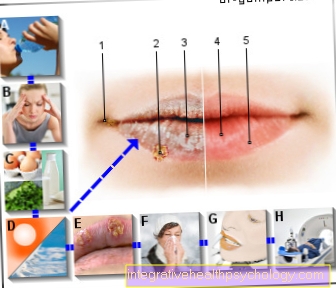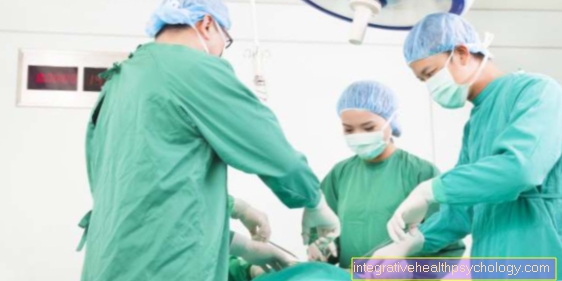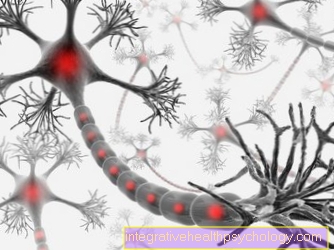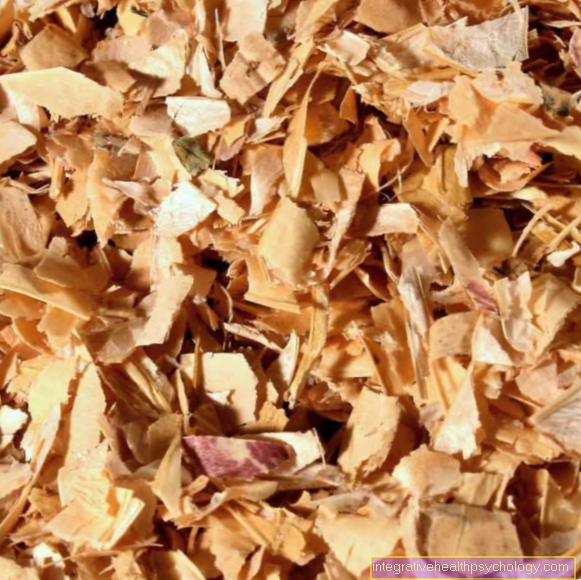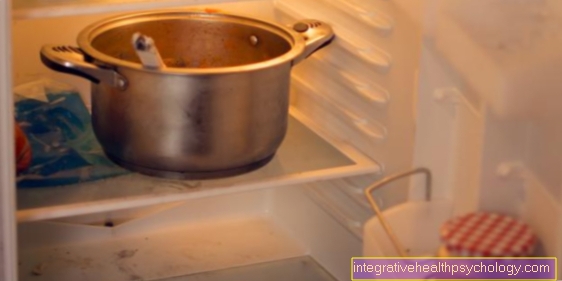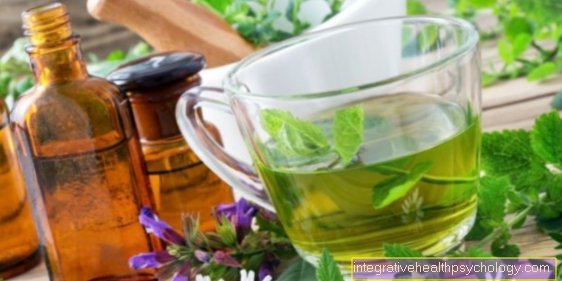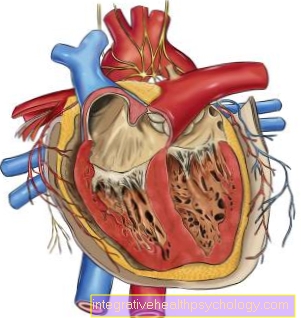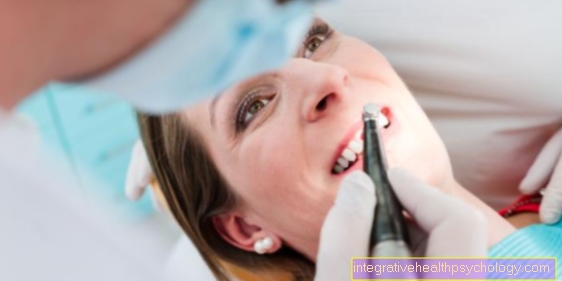Inflammation of the belly button in adults
introduction
Belly button infections in adults are rare.
They occur mainly in infants through bacterial transmission during birth. Infections mainly occur in developing countries due to poor hygiene and there contribute to a high proportion of infant mortality. An inflammation of the belly button can have serious complications as pathogens can enter the blood through the navel, causing sepsis (sepsis) can come.

Causes of navel infection
In contrast to newborns, inflammation of the belly button is very rare in adolescents and adults. When it occurs, it is often caused by navel piercings. There is a risk of infection, especially in the initial phase after the sting, when the wound has not yet healed.
In order to prevent inflammation of the navel from getting a piercing, care should be taken to ensure adequate hygiene when piercing, the area should be kept clean after the piercing and initially covered with a plaster.
If there is an inflammation, the piercing must be removed so that it can heal.
Inflammation in the context of navel piercings can also arise in connection with an existing contact allergy. In addition to piercings, the allergic reaction can also be triggered by belt buckles or trouser buttons, for example. A frequent contact allergy is the nickel allergy.
Also a special form of psoriasis (Inverse psoriasis) can cause inflammation of the belly button in adults. Psoriasis is a chronic skin disease. It is typical for inverse psoriasis that it occurs in the area of skin folds, which means that the belly button is a preferred location next to the armpit and the groin. The skin on the navel is reddened inversely in the case of psoriasis and a slight training can be noticed. However, this does not necessarily have to be present.
Read more about the topic here: Inflammation of the navel piercing
Inflammation of the belly button after an operation
Especially in laparoscopies - operations in which small incisions are made with cameras and certain medical instruments in the abdomen - a small incision is often made near the navel.
If this does not heal well after the operation and becomes inflamed, the navel can become infected. It is therefore important to take good care of the wound after an operation. Diabetics are particularly prone to inflammation of wounds because they have a depressed immune system.
You may also be interested in this topic: Wound healing disorder
Inflammation of the belly button due to fungal infection
As described above, the navel is also a good environment for mushrooms. These grow preferentially in warm and moist skin folds.
The most common fungal pathogens are dermatophytes (thread fungi). They cause a scaly reddening at the edge. In addition, itching usually occurs.
Thorough hygiene is important against fungal infections, as well as keeping the affected regions dry. If the clinical picture is pronounced, the doctor can also prescribe an antifungal agent, a so-called antimycotic.
Find out more about the topic here: Skin fungus
Figure causes a navel infection

Inflammation of the belly button -
Omphalitis
- Umbilical ring -
Umbilical annulus - Middle umbilical fold -
Plica umbilicalis mediana - Redness of the navel
- Swelling and
overheat - Discharge of purulent
or bloody secretions
Causes a
Inflammation of the belly button:
A. - infection
of the small remnant of the umbilical cord
(Period - birth up to four weeks)
B. - Navel piercing -
possible entry points
for bacteria
C. - Chronic skin diseases
like psoriasis inversa
(a form of psoriasis)
D. - Contact allergies -
z. B. Nickel allergy
(Pants buttons, piercing)
E. - Pregnancy -
Tension of the abdominal wall
Growth and Child Movements
F. - After a laparoscopy
(Laparoscopy) -
possible settling of bacteria
You can find an overview of all Dr-Gumpert images at: medical illustrations
Symptoms of inflammation of the belly button
Characteristically, the skin around the navel is reddened, overheated, swollen and partially torn.
In addition to redness and swelling, secretion is also one of the typical characteristics of a navel inflammation. The secretion has a strong unpleasant odor and is purulent. The secretion can sometimes be bloody and the navel can bulge outwards due to the inflammation. Signs that the inflammation is spreading are blisters and small bleeding in the skin, around the navel.
Read more on the topic:
- Pus in / out of the navel
- Belly button is bleeding - what could be behind it?
Smelly navel
A smelly navel can be caused by poor hygiene. Especially with deep navel, lint from clothing, dirt or flakes of skin can collect more easily. Bacteria also settle there.
The belly button is particularly susceptible to germs as it is relatively warm and moist. This creates the perfect environment for some types of bacteria. But this can also be a good environment for mushrooms. These can also lead to a smelly belly button.
A colonization of the navel with bacteria does not have to, but can lead to a navel infection. Then, in addition to the unpleasant smell, there is also pain.
You can also find out more at: Belly button stinks - what's behind it?
Pain from inflammation of the belly button
An inflammatory response is usually accompanied by pain.
The sensitivity to pain often correlates with the intensity of the inflammation. Touching and moving in particular can be painful. In addition to the pain, inflammation also causes redness and swelling of the affected areas. With a fungal attack, the pain is often less pronounced.
Fistula on the navel
Fistulas are tubular channels that connect two body cavities or one body cavity to the surface of the skin. They occur as part of diseases or are artificially produced during operations. The entrance to the canal can be seen on the surface of the skin. Fistulas occur particularly with Chron's disease, an inflammatory bowel disease. Fistulas are often associated with inflammatory processes.
If a navel inflammation occurs combined with a fistula, this should definitely be examined by a doctor. Then the cause should be clarified and the fistula treated. Unfortunately, fistulas are difficult to treat and the healing process takes a long time.
More information on this topic:
- Fistula on the navel
- The uracheal fistula symptoms and therapy
Inflammation of the belly button in adults with pus
With an abscess, a pus cavity forms. It is accompanied by reddening and swelling of the affected area. Furthermore, the area feels warmer than the surrounding skin. An abscess on the belly button is also associated with pain. Touch and movement are especially painful. The cause of abscesses are bacteria. This is particularly common here Staphylococcus aureus.
If you suspect an abscess, you should see a doctor. Because an abscess should always be opened for treatment so that the pus can drain and the affected tissue can heal. Then clean wound care is necessary to prevent re-infection. In some cases it is also important to take antibiotics.
You may also be interested in this topic: Abscess on the abdomen
Therapy of an inflammation of the belly button
It usually helps to let a lot of air get to the inflamed navel. The aim is to dry out the area, as the causing bacteria prefer a moist environment, which is taken away from them.
Furthermore, the area should be well disinfected and cleaned with lukewarm water or chamomile solutions. If the infection is persistent, a pathogen-specific antibiotic treatment may be necessary, which is aimed specifically against the triggering bacteria. In addition, antiseptic (germ-reducing) ointments are used locally. If the inflammation of the belly button is widespread, an antibiotic is used, which acts on the entire body. At an early stage, however, it is usually sufficient to only use antibiotic and antiseptic ointments locally.
If an abscess formation occurs as part of the inflammation of the navel, it must be surgically removed. If there is a contact allergy, the triggering substance must logically be avoided so that there can be an improvement.
Which ointments help with inflammation of the belly button in adults?
There is a large number of antiseptic, i.e. germ-reducing, ointments for treating navel infections.
- One example is the Betaisodona® ointment. Betaisadona contains antibacterial iodine and is widely used.
- If the belly button is additionally wet, zinc ointment can be used. Zinc ointment removes water from the wound and can lead to dehydration. In addition, zinc ointment is anti-inflammatory.
- If the skin is very dry, Bepanthen® can be used.
- In some cases, fungal infections of the belly button are caused by fungi. Then a special ointment must be used, which works against fungi.These ointments are called antifungal drugs.
Zinc ointment for navel infections
Zinc ointments have a slightly disinfectant effect and are used for superficial inflammation of the skin so that the inflammation does not spread any further.
They can also be used to treat inflammation of the belly button. It is also used for itchy and oozing surfaces, as it has a drying effect in addition to being anti-inflammatory. However, zinc ointment should not be applied to open wounds.
Home remedies for navel infections in adults
There are a variety of home remedies for belly button infections that can be used independently. However, if there is pronounced inflammation, their use should be discussed with a doctor.
One way to fight inflammation is to rinse your belly button with salt water. The salt has an anti-inflammatory effect and removes water from the skin.
Coconut oil or tea tree oil can also be applied to the navel. The two oils also have an antibacterial effect. These methods can be used several times a day.
Warm compresses can be placed on the belly button for pain relief and calming. They should be wrung out well beforehand so that water does not collect in the navel.
A paste made from turmeric and water can also be applied to the inflamed navel. After an exposure time, the paste must be washed off again. Turmeric has anti-inflammatory effects. It can also reduce itching. Anti-inflammatory baths with chamomile or calendula can also be used. After each use, the navel should be carefully dabbed dry.
Homeopathy for navel infections
The aloe vera gel can be used against navel infections. This is applied to the navel. After a quarter of an hour, the aloe vera gel is washed out again.
A homeopathic remedy that is used for inflammation and abscesses is Hepar sulfuris.
Learn more at: Homeopathy for skin inflammation
Complications of inflammation of the belly button
One of the most important complications of inflammation of the belly button is blood poisoning (sepsis). Signs of blood poisoning can include a high fever, increased heart rate, and increased breathing.
In addition to blood poisoning, peritonitis can also develop, which is very dangerous. Furthermore, the surrounding tissue can die off as a result of the infection. This happens to a special extent when the inflammation of the navel is a so-called necrotizing fasciitis. Rarely, as a complication, abscess formation in the liver or spreading to the heart wall can occur (endocarditis).
Differences from belly button inflammation in babies
In adults, inflammation of the belly button is usually much more harmless. Typically, inflammation of the belly button manifests itself in the first few days of a newborn's life. Inflammation of the belly button is rather uncommon in adults.
Compared to adults, newborns are much more susceptible to infections because their immune system is very weak and has not yet come into contact with many bacteria, meaning that their immune system cannot react quickly enough to the pathogens. The skin of newborns does not come into contact with bacteria until they are born, as they are washed around with amniotic fluid, which is completely free of bacteria. Due to the weaker immune system, babies and children are also more likely to experience complications such as blood poisoning than adults.
Read more on the subject at:
- Inflammation of the belly button in the baby
- Inflammation of the belly button in the child
Inflammation of the belly button during pregnancy
In some adults, inflammation of the belly button can also occur during pregnancy.
In this case, pathogens can enter through small tears in the skin and lead to an infection. The skin tears are caused by the increasing growth of the child, in the course of which there is increasing tension in the abdominal skin. At some point the skin can no longer withstand this tension, so that small tears occur, but most of them are so small that you cannot see them yourself.
You may also be interested in this topic: Infections in pregnancy
Diagnosis of inflammation of the belly button
A navel infection is usually a visual diagnosis, as it is usually manifested by its typical triad of redness, swelling and secretion.
To identify the pathogen, the attending physician takes a swab from the navel so that a bacterial culture can be created in the laboratory. The exact determination of the pathogen is important so that a targeted therapy with an antibiotic can take place if the infection is persistent.
In addition, blood is often drawn to check whether the inflammation levels have risen and whether there are any signs of blood poisoning. If the inflammation is suspected to have spread, an ultrasound scan of the abdomen can be done to rule out a liver abscess, for example.
Recommendations from the editorial team
- My belly button is bleeding- what can that be?
- Inflammation of the belly button in the baby
- Inflammation of the belly button in the child
- Inflammation of the navel piercing
- Blood poisoning

